Pages
- Home
- North Alabama
- Central Alabama
- South Alabama
- East Alabama
- West Alabama
- FEATURE BUSINESS
- Business Directory
- The Cumberland Mall
- Career
- COOL STUFF
- Culture & Arts
- DEALS!
- Economy
- Education
- Environment
- Food
- Health
- Our Farmers
- Politics
- Real Estate
- Science
- Tech
- Travel
- Democratic Party
- Local Democratic Party
- Republican Party
- Local Republican Party
Wednesday 23 2023
Saturday 19 2023
NASA’s Psyche mission to a metal world may reveal the mysteries of Earth’s interior

French novelist Jules Verne delighted 19th-century readers with the tantalizing notion that a journey to the center of the Earth was actually plausible.
Since then, scientists have long acknowledged that Verne’s literary journey was only science fiction. The extreme temperatures of the Earth’s interior – around 10,000 degrees Fahrenheit (5,537 Celsius) at the core – and the accompanying crushing pressure, which is millions of times more than at the surface, prevent people from venturing down very far.
Still, there are a few things known about the Earth’s interior. For example, geophysicists discovered that the core consists of a solid sphere of iron and nickel that comprises 20% of the Earth’s radius, surrounded by a shell of molten iron and nickel that spans an additional 15% of Earth’s radius.
That, and the rest of our knowledge about our world’s interior, was learned indirectly – either by studying Earth’s magnetic field or the way earthquake waves bounce off different layers below the Earth’s surface.
But indirect discovery has its limitations. How can scientists find out more about our planet’s deep interior?
Planetary scientists like me think the best way to learn about inner Earth is in outer space. NASA’s robotic mission to a metal world is scheduled for liftoff on Oct. 5, 2023. That mission, the spacecraft traveling there, and the world it will explore all have the same name – Psyche. And for six years now, I’ve been part of NASA’s Psyche team.
About the asteroid Psyche
Asteroids are small worlds, with some the size of small cities and others as large as small countries. They are the leftover building blocks from our solar system’s early and violent period, a time of planetary formation.
Although most are rocky, icy or a combination of both, perhaps 20% of asteroids are worlds made of metal, and similar in composition to the Earth’s core. So it’s tempting to imagine that these metallic asteroids are pieces of the cores of once-existing planets, ripped apart by ancient cosmic collisions with each other. Maybe, by studying these pieces, scientists could find out directly what a planetary core is like.
Psyche is the largest-known of the metallic asteroids. Discovered in 1852, Psyche has the width of Massachusetts, a squashed spherical shape reminiscent of a pincushion, and an orbit between Mars and Jupiter in the main asteroid belt. An amateur astronomer can see Psyche with a backyard telescope, but it appears only as a pinpoint of light.
About the Psyche mission
In early 2017, NASA approved the US$1 billion mission to Psyche. To do its work, there’s no need for the uncrewed spacecraft to land – instead, it will orbit the asteroid repeatedly and methodically, starting from 435 miles (700 kilometers) out and then going down to 46 miles (75 km) from the surface, and perhaps even lower.
Once it arrives in August 2029, the probe will spend 26 months mapping the asteroid’s geology, topography and gravity; it will search for evidence of a magnetic field; and it will compare the asteroid’s composition with what scientists know, or think we know, about Earth’s core.
The central questions are these: Is Psyche really an exposed planetary core? Is the asteroid one big bedrock boulder, a rubble pile of smaller boulders, or something else entirely? Are there clues that the previous outer layers of this small world – the crust and mantle – were violently stripped away long ago? And maybe the most critical question: Can what we learn about Psyche be extrapolated to solve some of the mysteries about the Earth’s core?

About the spacecraft Psyche
The probe’s body is about the same size and mass as a large SUV. Solar panels, stretching a bit wider than a tennis court, power the cameras, spectrometers and other systems.
A SpaceX Falcon Heavy rocket will take Psyche off the Earth. The rest of the way, Psyche will rely on ion propulsion – the gentle pressure of ionized xenon gas jetting out of a nozzle provides a continuous, reliable and low-cost way to propel spacecraft out into the solar system.
The journey, a slow spiral of 2.5 billion miles (4 billion km) that includes a gravity-assist flyby past Mars, will take nearly six years. Throughout the cruise, the Psyche team at NASA’s Jet Propulsion Laboratory in Pasadena, California, and here at Arizona State University in Tempe, will stay in regular contact with the spacecraft. Our team will send and receive data using NASA’s Deep Space Network of giant radio antennas.
Even if we learn that Psyche is not an ancient planetary core, we’re bound to significantly add to our body of knowledge about the solar system and the way planets form. After all, Psyche is still unlike any world humans have ever visited. Maybe we can’t yet journey to the center of the Earth, but robotic avatars to places like Psyche can help unlock the mysteries hidden deep inside the planets – including our own.
Jim Bell, Professor of Earth and Space Exploration, Arizona State University
This article is republished from The Conversation under a Creative Commons license.
The movie ‘Barbie’ has put the phrase ‘toxic femininity’ back in the news – here’s what it means and why you should care

As the “Barbie” movie’s worldwide box office passes the billion-dollar mark, and some conservative pundits push back against its popularity with negative hot takes, the phrase “toxic femininity” is back in the news.
On National Public Radio’s “It’s Been a Minute,” panelists discussing “Barbie” speculated about whether toxic femininity exists as the opposite of toxic masculinity. Conservative pundits have been less tentative. A Salon story reporting on conservative coverage of the film noted that the right wing has blasted “Barbie” with charges of toxic femininity. On Fox News, conservative panelist Douglas Murray associated the movie – which he admitted to not having seen – with toxic femininity.
The phrase toxic femininity has become popular with conservatives in recent years. However, it lacks a consistent definition and is often invoked by people with competing and even opposing views about women, men and gender.
As a scholar of gender and communication, I study how language shapes people’s understanding of themselves, others and society. Examining how toxic femininity means different things to different people reveals important insights about gender, power and how language affects our well-being.
Toxic masculinity
First, it’s important to consider the role the predecessor of toxic femininity – “toxic masculinity” – has played in U.S. culture.
Clinical psychologists, academics and feminist advocates have used the phrase to describe a pernicious form of manhood that has produced widespread harm.
Sociologist Michael Flood explains that “the phrase emphasizes the worst aspects of stereotypically masculine attributes,” including “violence, dominance, emotional illiteracy, sexual entitlement, and hostility to femininity.”
The term first appeared in the 1980s but recently has gained prominence in public discussion, cited as a contributing factor to mass shootings, the exploitative behavior exposed by the #MeToo movement, and Donald Trump’s persona and political popularity.

Not all academics agree that using a gendered label to describe structural oppression is helpful. Cultural studies scholar Carol Harrington warns that labeling the outgrowths of patriarchy and misogyny as toxic masculinity shifts responsibility from harmful social systems to the behavior of “‘backward’ and ‘mentally unwell’ men,” making sexism an individual, rather than societal, problem.
Nevertheless, when critics talk about toxic masculinity they are invoking a term that has had a mostly consistent meaning for 30 years. The same cannot be said for toxic femininity.
The many faces of toxic femininity
Toxic femininity is a relatively new phrase that emerged in response to conversations about toxic masculinity.
But people who use the term often have very different motivations for doing so – from altruistic concern about the harms of sexism to indignation over men’s ostensibly dwindling power in society. Given these diverse motivations, people often employ the phrase to mean wildly different things.
Psychologists such as Meaghan Rice see toxic femininity as the inverse of toxic masculinity – a constellation of characteristics like meekness, emotionalism, passivity and self-sacrifice. Writing for “Psychology Today,” psychologist Ritch C. Savin-Williams describes toxic femininity as “internalized misogyny” that encourages women to ignore their “mental or physical needs to sustain those around them.”
In other words, toxic femininity is what many people think of as “stereotypical femininity” and is a product of patriarchal gender norms. In this formulation, toxic masculinity and toxic femininity are both fueled by sexism, and each erodes human thriving.
A different perspective regards toxic femininity not as a stereotypical notion of gendered weakness but as an inappropriate demonstration of female strength, cunning or privilege. Psychologists Shoba Sreenivasan and Linda E. Weinberger ascribe the trait to professional women who are “hostile to nurturance and cooperation, opting instead for aggression and backstabbing to get ahead.”
Similarly, organizational psychologist Nancy Doyle links “toxic femininity at work” to the infamous “Karen” meme, which refers to white women who use their gender and whiteness to manipulate or dominate others. This version presents toxic femininity as a woman’s version of the domineering individualism that drives toxic masculinity.
The conservative pundits arrayed against both “Barbie” and feminism, more broadly, are promoting a third definition of toxic femininity. Cultural studies scholar Hannah McCann explains that many men’s rights activists deploy the term as a rebuff of assertions about toxic masculinity, arguing that men are victimized by “toxic” women – not the other way around.
Conservative pundits like Matt Walsh and author Jeff Minick invoke toxic femininity to oppose feminism writ large. Right-wing commentator Candace Owens tweeted, “Terms like ‘toxic masculinity’, were created by toxic females.”
Carrie Gress, author of “The Anti-Mary Exposed: Rescuing the Culture from Toxic Femininity,” takes this perspective to the extreme, asserting that the pro-choice radical feminism of the 1960s ushered in a cultural and spiritual transformation that “led to the toxic femininity that has destroyed the lives of countless men, women and children.”
The right-wing iteration of toxic femininity attempts to neutralize the argument that patriarchy systematically disadvantages women and others who fail to fit traditional gender norms. Toxic femininity is regarded as equally dangerous to men – or even more – as toxic masculinity is to women.
Beyond a toxic gender binary
In her examination of popular discussions of toxic masculinity and femininity, McCann argues that what makes gender ideology toxic is rigidity – adherence to an inflexible gender binary. Gender norms are scripts that direct people to behave in ways that are consistent with one group’s ideas about what it means to be a woman or a man.
Of course, these scripts leave many people feeling uncomfortably constrained – not only the men and women who buck tradition, but also nonbinary, transgender and other people whose existence demonstrates that a gender binary is too simplistic to account for the fullness of human experience.
In the end, the movie “Barbie” recognizes the toxicities of both the matriarchal and patriarchal versions of Barbieland. Director Greta Gerwig’s happy ending requires Margot Robbie’s stereotypical Barbie to leave Barbieland for the real world, where she can forge a unique, less toxic, identity.
Karrin Vasby Anderson, Professor of Communication Studies, Colorado State University
This article is republished from The Conversation under a Creative Commons license.
Friday 18 2023
Monday 14 2023
Contacting your legislator? Cite your sources – if you want them to listen to you

Suppose you have an issue you are really passionate about – taxes, gun control or some other important policy. You want to do more than vent on social media, so you decide to write an email, place a phone call or even draft a letter to your state legislator expressing your views.
As a citizen, I would praise your sense of civic responsibility and willingness to express your opinion. As a scholar, I would encourage your efforts – they’re more consequential than many people realize.
I teach communication and public policy at Michigan State University and study how constitutents’ communication with lawmakers affects public policy decisions.
In my previous research, I analyzed – with their permission – the efforts of coalitions working to get citizens to contact their lawmakers in support of major legislation in New Hampshire and Michigan. I conducted a rigorous evaluation of the types of contact constituents made, the messages they conveyed and the behavior of lawmakers both before and after receiving those communications.
The results showed that communications from constituents can have a large impact on how legislators vote. For example, emails from constituents encouraging policymakers to support smoke-free workplace bills in New Hampshire increased state legislators’ support on critical votes by an estimated 20 percentage points – a substantial effect.
But a lot of people don’t bother to contact their elected officials, thinking it’s not worth communicating with them.
In today’s polarized political environment, is it possible to get through to policymakers from the other side?
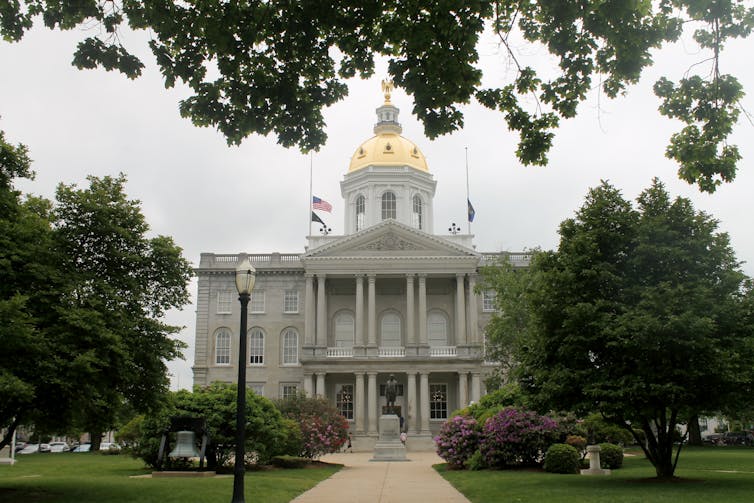
Discounting opposing views
Some work, including my own mentioned above, suggests that policymakers are responsive to communications from the public. But research has also shown that policymakers engage in what’s called biased reasoning, writing off communications from constituents who do not share their policy views.
For instance, political scientists Daniel Butler and Adam Dynes asked state and local policymakers in two online surveys to evaluate a hypothetical communication from a constituent. Policymakers were randomly assigned to evaluate a letter that either supported or opposed a controversial policy and then rated the hypothetical writer letter on various characteristics.
The authors found that policymakers rated hypothetical constituents who disagreed with them as less knowledgeable about the topic. This discounting of constituents who disagree on policy could explain why policymakers tend to have biased perceptions of public opinion, believing the public’s attitudes to be more in line with their own positions than polling suggests.
Is there a way to prevent lawmakers from writing off constituents’ perspectives?
Do your research
In recent work with political communication scholars Hillary Shulman and Dustin Carnahan, I sought to develop strategies to limit policymakers’ discounting of constituents’ opinions.
We asked a national sample of elected local policymakers – among them city council members – to evaluate a hypothetical email writer randomly assigned to express support or opposition to raising the minimum wage. The survey was fielded by Civic Pulse, which specializes in samples of elected officials.
This study was similar to the Butler and Dynes study described above. But we added two randomly assigned conditions – what we called a “read” condition in which the writer expressed having “read a lot about” the topic, without any specific detail, or a “cite” condition in which the writer summarized and cited a study supporting their position.
We anticipated, based on research on biased reasoning, that providing clear evidence that the constituent is knowledgeable about the issue would prevent biased discounting of constituent opinion.
Policymakers in our study were asked to evaluate to what extent they thought that the constituent understood the issue, was representative of the community, and was sincere and held their position strongly, and whether they thought the communication was a form letter rather than a constituent-intitiated communication – and therefore presumably more likely to be written off.
How to not be written off
The results confirmed previous findings that policymakers indeed discount the opinions of constituents with whom they disagree. When policymakers read an email expressing an opinion that differed from their own on raising the minimum wage, the email writer was rated lower across all five dimensions.
However, if the email writer provided evidence that they knew about the issue – citing research supporting their position – policymakers were more likely to perceive that the email writer understood the issue. The effects of citing evidence are stronger than simply stating that one has read about the issue.
My own work suggests that a constituent expressing an opinion to an elected official can influence the official’s vote on the issue. But just writing to an official is no guarantee that the constituent will persuade the official or have the issue resolved in the way they prefer.
Our study is important in identifying a way constituents can avoid being written off.
We also found that there are no downsides to providing evidence supporting one’s position.
You might expect that when provided with unambiguous evidence that a disagreeing constituent understands the issue, policymakers might direct their efforts to discounting other constituent characteristics, rating the constituent as less sincere or less representative of the community.
We did not find any evidence that this happened. When faced with evidence that their constituent knows the issue well, policymakers are less likely to discount their opinions.

How to be heard
The practical results are clear: When communicating with a policymaker, especially one with whom you disagree, you want to stop them from discounting your opinion. One way to do this is by citing quality evidence to support your position.
While this advice seems straightforward, it did not appear in guides we surveyed created by citizen groups like the Sierra Club, ACLU or Christian Coalition.
When contacting a policymaker about an issue, be aware that they may discount your opinion if they disagree.
But note also that carefully crafted communications can convey your position without being written off – and could improve how accurately the policymaker understands public attitudes about public policies.
Daniel E Bergan, Associate Professor in Communication & Public Policy, Michigan State University
This article is republished from The Conversation under a Creative Commons license.
Smart Solutions for School
Must-have essentials for back-to-school season
With school bells ringing for students of all ages, it’s important to make sure your student has all the necessities to be successful this year.
While that often means running from store to store in search of supplies, stylish clothes and other essentials, these top picks for securing valuables, decorating dorm rooms, planning out schedules, getting necessary nutrition and staying hydrated can help ensure your student is geared up for success in the classroom and beyond.
Find more back-to-school essentials and tips for success in the classroom at eLivingtoday.com.
Protect New Purchases on Campus
A new school year brings plenty of excitement, but it can also be stressful for students moving away from home who need to safeguard valuables like tablets, smartphones, passports, or an emergency credit card. To help alleviate back-to-school worries, SentrySafe, a leading name in fire-resistant and security storage for more than 90 years, offers solutions to provide peace of mind for parents and students. An affordable, convenient, and fireproof option, the 1200 Fire Chest protects items against fires up to 1,500 F for 30 minutes. It also features a built-in key lock and convenient handle for added security and simplified transport. Find more back-to-school security solutions at sentrysafe.com.

Quick and Easy Meals That Deserve an A+
Keeping weeknight dinners and school lunches simple means more time for family and less stress during the week. Cook up quick and easy weeknight dinners, school lunches or on-the-go snacks with Minute Rice Cups. Ready in only 1 minute, the BPA-free cups are available in a variety of flavors such as Chicken & Herb, Cilantro & Lime, Jalapeno and more. Visit MinuteRice.com to get meal ideas today.

Make Organization Personal
Help your student keep notes, study times and test dates organized with a quality planner that also showcases his or her personality. Available in a myriad of trendy colors and patterns – like polka dots, stripes or chevron – as well as various calendar layouts like daily, weekly or monthly, the right planner can help students of all ages stay on track, achieve goals and preserve memories in one stylish and organized place.

Sleep in Style
Where a student sleeps may be one of the last things on his or her mind when thinking about the excitement that awaits in college but getting plenty of sleep is key to success. Amp the appeal of the dorm-issue mattress with stylish and comfy bedding that reflects your personality. Look for quality threads you can snuggle into, and coordinate with pillows to make your bed a cozy place to sit and study by day.

Take H2O on the Go
A durable reusable water bottle can make your back-to-school routine even easier. With a variety of sizes and styles available in a multitude of colors and designs, there’s almost certain to be an option for students of all ages and activity levels. Look for durable, leak-proof stainless steel or hard plastic options that offer different lid styles, including wide-opening or those with retractable straws, to make hydrating on the walk between classes a breeze.
SentrySafe
Minute Rice
Breaking Better-for-You Bread: Quick and easy keto-friendly meal ideas
For many looking to make healthy dietary changes, weight loss is a primary concern. Because the Dietary Guidelines for Americans recommend 45-65% of daily calories come from carbohydrates, an eating plan like the ketogenic diet (or keto, for short), which involves consuming a low amount of carbs and replacing them with healthy fats, can be a popular choice for achieving weight loss goals.
Replacing carb intake with fat can put your body in a metabolic state called ketosis, which makes you more efficient at burning fat for energy. The keto diet can also help reduce blood sugar and insulin levels and lower risk for certain diseases.
Those following the keto eating plan typically significantly reduce or avoid consuming bread, pasta, rice and baked goods, which are all traditionally high in carbohydrates. However, Toufayan Bakeries introduced a line of keto-friendly wraps, pitas and flatbreads that are high in fiber and protein while containing no sugar and being lower in carbs than traditional bread.
“We take great pride in baking our family’s favorite breads for families across the U.S.,” said Karen Toufayan, VP of marketing for Toufayan. “Across the country, people following the keto diet have been missing their favorite bread products. We are thrilled to introduce Toufayan’s first line of keto-friendly breads and hope they love them as much as we do.”
Try serving these satisfyingly light solutions as the base ingredients in these delicious recipes for a Keto Egg and Sausage Flatbread or Keto Enchilada Quesadilla from chef George Duran.
Find more recipes to support a ketogenic eating plan at Toufayan.com.
Keto Enchilada Quesadilla
Recipe courtesy of chef George Duran
Yield: 1 quesadilla
- Rotisserie chicken, pulled and chopped
- enchilada Sauce
- olive oil
- Toufayan Bakeries Keto Wraps
- Tex-Mex cheese, grated
- jarred or fresh jalapenos, thinly sliced
- cilantro, chopped
- salsa, for serving
- In bowl, mix pulled chicken and enchilada sauce until fully covered. Set aside.
- Spray or brush olive on both sides of keto wrap and place on nonstick pan or skillet over medium heat. Once wrap is heated on one side, flip and heavily top entire wrap with grated cheese. Allow cheese to melt then disperse chicken mixture, sliced jalapenos and chopped cilantro on half of wrap. Fold wrap over ingredients and cook until quesadilla is golden brown on both sides.
- Cut into three triangles and serve with salsa.

Keto Egg and Sausage Flatbread
Yield: 1 flatbread
- 1 Toufayan Keto Flatbread
- 1/4 cup shredded mozzarella cheese
- 2 cooked sausage links (approximately 2 ounces each), cut into pieces
- 1/4 cup thinly sliced red bell pepper
- 1 large egg
- 1 tablespoon fresh chives
- salt, to taste
- pepper, to taste
- Preheat oven to broil.
- On foil-lined baking sheet, place flatbread and top with mozzarella cheese; add sausage pieces and bell pepper.
- Crack egg in center of flatbread and broil 5-8 minutes, or until egg is cooked to desired firmness.
- Remove from oven and top with chives.
- Season with salt and pepper, to taste, and serve.
Nutritional information per serving (1 flatbread): 435 calories; 29.1 g protein; 25.6 g fat; 8.6 net carbs.
Toufayan
Yellow jerseys of the fireline: A day fighting wildfires can require as much endurance as riding the Tour de France

For three weeks in July, the world’s most elite bike racers climb steep mountains and sprint along historic cobblestones to capture the coveted yellow jersey or the race leader in the Tour de France. It’s a 22-day feat of human endurance that requires constant eating and drinking to manage the average daily energy demand of about 6,000 calories, equivalent to around 12 McDonald’s Happy Meals, and just over 1.5 gallons of water.
Nearly 5,000 miles away in the mountains of North America, radios crackle with chatter from a wildfire incident command post, air operations and other crews fighting a wildfire. Up the fireline, the swings of Pulaskis, axlike hand tools, are carving a fuel break into the land. The weather forecast predicts a high of nearly 100 degrees Fahrenheit (38 C) with wind, a combination that can push the fire high up into the canopy of dense lodgepole pines on the mountainside.
The yellow jerseys here are sooty, sweat-stained and flame-resistant, with a strong, earthy odor.
Hotshot crews like this one are the elite workforce of the forest, and the demand on their bodies can rival that of the cyclists in the Tour de France, as my team’s research shows.
On this morning, the Hotshot crew has already hiked 3 miles up steep, uneven terrain and built nearly 1,200 feet of fire line. It is not yet 10 a.m. The day is just beginning, the first day of a 14-day rollout.
Measuring the physical strain
The dew hangs heavy on the inside of the small tent as the 4:30 a.m. alarm disrupts my intermittent sleep. The sounds of sleeping bag and tent zippers signals the beginning of a new day in a remote Montana fire camp.
Using a headlamp, I arrange the sample collection tubes in a plastic rack and wait for a few members of the Lolo Hotshots to wander through my field laboratory to drop off an early morning urine sample.
The crew is participating in a study that my team from Montana is conducting to measure the physical strain and total energy demands of work on an active wildfire, with the goal of finding ways to improve firefighter fueling strategies and ultimately health and safety on the line.
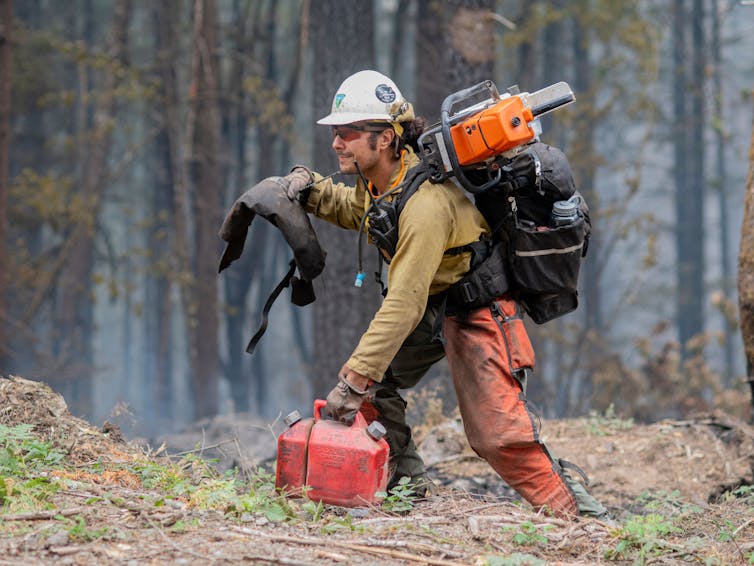
Crew members are outfitted with a series of lightweight monitors that measure heart rate, as well as movement patterns and speed using GPS. Each swallows a temperature-tracking sensor before breakfast that will transmit measures of core body temperature each minute throughout the work shift.
Just before 6 a.m., the crew heads west in their crew carrier rigs into the adjacent wilderness. They have lines to dig and a fire to contain.
Burning 6-14 calories per minute
On the fire line, pack straps dig into the neck and shoulders with each swing of the Pulaski. It’s a constant reminder that everything wildland firefighters need, they carry, all day.
The critical water and food items, supplies, extra gear, and fire line tools – Pulaskis, chain saws, and fuel – add up to an average gear weight often exceeding 50 pounds.
Hiking with a load and digging firelines with hand tools burns about 6 to 14 calories per minute. Heart rates rise in response to an increased pace of digging.
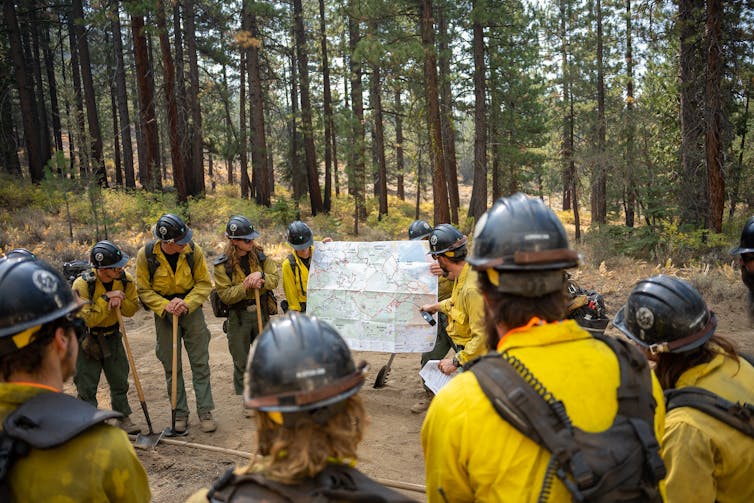
Measured with the same techniques used to quantify the energy demands of Tour de France riders, wildland firefighters demonstrate an average total energy expenditure approaching 4,000 to 5,000 calories per day. Some days can exceed the Tour’s average of about 6,000 calories. Add to that a daily water need of 1.5 to over 2 gallons.
This isn’t just for a few days. Fire season in the western United States can last five months or more, with most Hotshot crews accumulating four to five times the number of operational days of the 22-day Tour de France and over 1,000 hours of overtime.
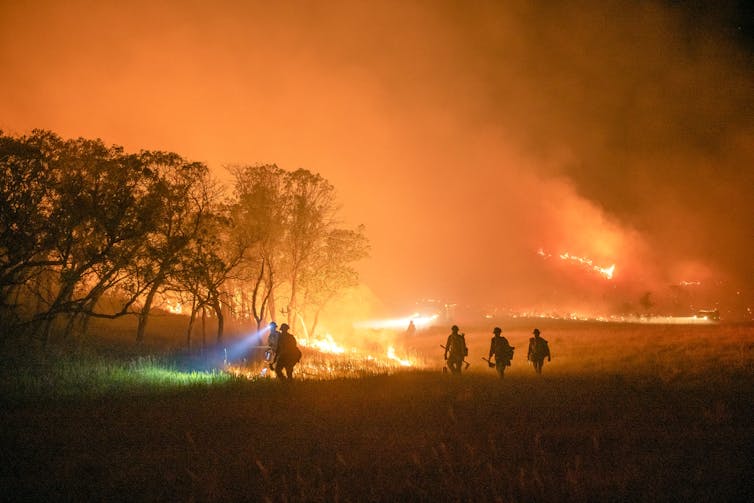
Every year, on average, about 60,000 wildfires will burn across roughly 70 million acres in the western U.S. Drying grasses and forests create fuel for the spark of a lightning strike, power line or carelessly abandoned campfire, and windy summer weather can spread that into a blaze. When those fires could threaten communities, the Hotshots are mobilized.
Impact on the wildland firefighter’s body
As the work shift progresses, the Hotshots constantly monitor their surroundings and self-regulate nutrient and fluid intake, knowing their shift will last 12 to 16 hours.
During intense activity in high heat, their fluid intake can increase to 32 ounces per hour or more.
The highest-intensity activity is generally during the early morning hike to the fire line. However, the metabolic demands can sharply increase if crews are forced into a rapid emergency evacuation from the fire, as more than 25 years of wildland firefighter physiology research shows.
The most effective way for wildland firefighters to stay fueled is to eat small meals frequently throughout the work shift, similar to the patterns perfected by riders in the Tour. This preserves cognitive health, helping firefighters stay focused and sharp for making potentially lifesaving decisions and keenly aware of their ever-dynamic surroundings, and boosts work performance. It also helps slow the depletion of important muscle fuel.
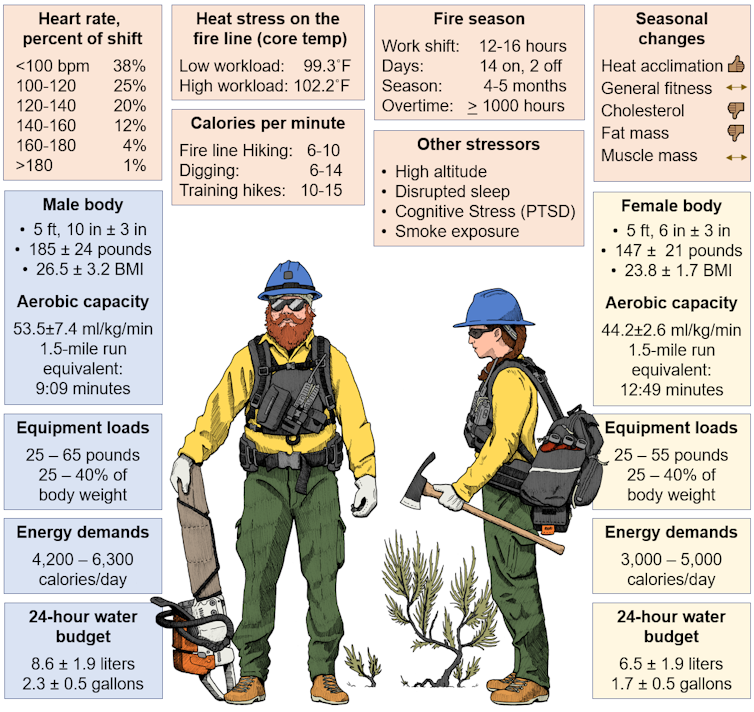
Despite the physical and emotional stress of being in an active fire, the firefighters’ heart rates rarely exceed 160 beats per minute, about 70% to 80% of maximal heart rate and an intensity common during a higher-intensity training run. Their heart rates are mostly maintained between 100 and 140 beats per minute, typical of a brisk walk or hike, but they maintain that for hours.
Although crews gradually acclimatize to the heat over the season, the risk for heat exhaustion is ever present if the work rate is not kept in check. This cannot be prevented by simply drinking more water during long work shifts. However, regular breaks and having a strong aerobic capacity provides some protection by reducing heat stress and overall risk.
The season takes a toll
Hotshots are physically fit, and they train for the fire season just as many athletes train for their competition season. Most crew members are hired temporarily during the fire season – typically from May to October, but expanding as the planet warms. And there are distinct fitness requirements for the job.
Still, with the immense physical demands of the job, crew members often experience a decay in metabolic and cardiovascular health and an increase in cholesterol, blood lipids and body fat. It is unclear why such a hardworking job often makes firefighters less healthy, requiring an off-season reset to recover, retrain and rebuild.
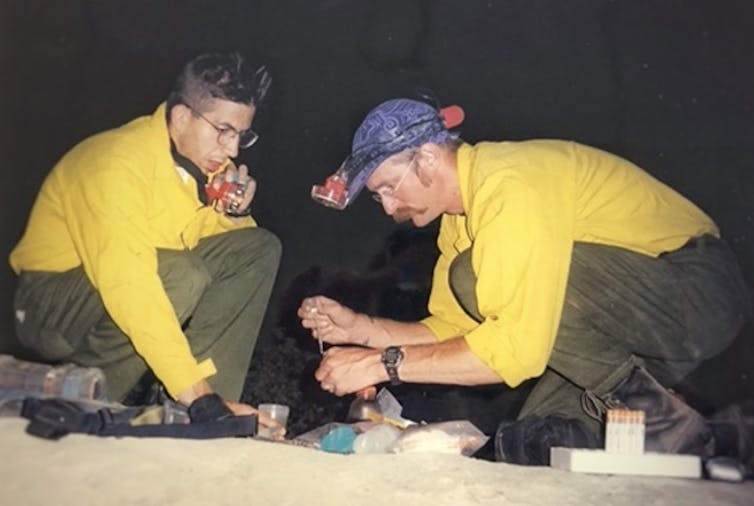
The season causes damage. This unfolds counter to the commonly accepted benefits of regular exercise. Pollutant and smoke exposure, lapses in nutrition, sleep disorders and chronic stress during the season seems to gradually poke holes in the Hotshot armor.
Progressive intervention strategies can help, such as educational programs to inform specific physical training and nutritional needs, mindfulness training to reduce the risk of job-oriented anxiety and depression and emotional support for individual crew members and families.
Developing off-season practices that pay close attention to both physical and mental health recovery can help limit harm to firefighters’ health. Many Hotshots bounce back and return season after season.
Back in camp
A 14-hour intervention with the land is physically and emotionally exhausting.
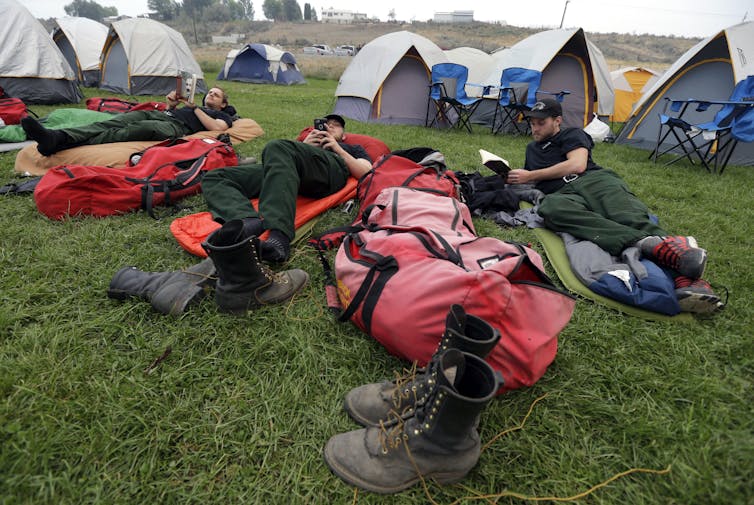
Back in camp, the crew provides another urine sample, and I download their monitors’ data. Their fireline stories have all the elements of American folklore and Western novels, and they bounce between excitement about the events of the day and wondering what the data from their sensors and tests might show. I will use that data combined with our previous research to help crews develop early-season training and advanced nutrition strategies.
A large, warm meal starts to reload precious muscle fuel. In a few hours, a new shift will begin for the Hotshots, and another day in the yellow jersey.
Brent C. Ruby, Research Professor, School of Integrative Physiology and Athletic Training, University of Montana
This article is republished from The Conversation under a Creative Commons license.
5 Tips to Set Your Kids Up for Back-to-School Success
Whether you’re dreading hectic school-day schedules or excited for kids to be back in the classroom, most parents agree the transition back to school can be a stressful time.
Change can be trying for kids and adults, but it doesn’t have to be if you tackle the season a little at a time – mentally, emotionally and logistically.
Consider these five school-readiness tips from KinderCare experts to help parents ease the jitters, prepare for school days and set goals to help ensure their children have great years.
- Ease into school-year routines. Many children thrive on routines. Prep for the transition to a school-day schedule as early as possible by slowly moving your children’s bedtimes up a little each evening. You should also establish school-year breakfast, lunch and dinner routines to help children adjust to regular mealtimes.
- Take a trial run and figure out what hiccups need addressing. Ask your children’s school if you can take an after-hours tour to increase familiarity and practice your routine. According to KinderCare’s Parent Confidence Report, 61% of parents believe being a parent means constantly thinking about child care gaps, so now is the time to make before- and after-school care arrangements and discuss them with your children. Help ease their nerves by making sure they practice the little things like opening and closing lunchboxes, water bottles and backpacks, and finding their drop off and pick up locations then adjust as needed to make sure they feel confident in each of the tasks.
- Start back-to-school conversations at home. Children sometimes experience big feelings, and they may not know how to explain what they’re experiencing. Whether it’s excitement, jitters or anxiety around the unknown, having open conversations at home about school can give children a comfortable space to share what they feel and help quell their nerves. This is also a good time to gently remind your children about kindness and acceptance of others. During the school year, monitor your children’s behavior to better understand how they may be feeling.
- Build strong home and school partnerships. One of the best things you can do for your children is give them the resources they need for success then support them along the way. One way to do this is by building partnerships with your children’s teachers to create a strong foundation for the entire school year. Whether it’s joining the local parent group at school, downloading a classroom app, following your children’s school social media pages or sending an informal “getting to know you” email to your children’s teachers, consistent and effective communication is often beneficial when you face challenges or have questions down the road.
- Set school-year goals. These don’t have to be formal; they can be impactful and fun, too. This may help your children understand what they’re working toward. Maybe they want to try a new sport or learn a musical instrument. Maybe they would like to increase their math competencies by a letter grade or demonstrate more patience while learning new things. Make a mental note to continuously revisit these goals throughout the year to celebrate progress and growth. Watch for ways you can help them accomplish these objectives with support from counselors, coaches and instructors as well as at home.
For more tips to help ensure a smooth back-to-school transition, visit kindercare.com.
KinderCare
Government support was key for thousands of US nonprofits battered by COVID-19’s early costs − new research

Government funding helped keep U.S. charities afloat during the first six months of the COVID-19 pandemic, according to a study I conducted with Stephanie Karol, a fellow economist.
We found that charitable donations declined by more than an estimated 20% during that period – which preceded a sharp end-of-year upswing in giving in late 2020. But the government grants to nonprofits, which soared during those six months by over 65%, and the Paycheck Protection Program – a government-run loan program established to support employers as the pandemic upended the economy – enabled many charities to retain their employees.
The pandemic hindered many donors’ ability to give, while also hampering the delivery of charitable services when nearly all indoor activities screeched to a halt. After analyzing data we obtained from the Internal Revenue Service and the Small Business Administration, another government agency, we found that when donations declined, from March to November 2020, charities spent less delivering their services. Spending by charities fell by 34%, as many of those groups struggled to keep going.
We found that nonprofit employment also suffered. The number of nonprofit jobs declined by 14%, and wages for the people charities employed fell by over 40% on average during this period of high U.S. unemployment. The arts were particularly hard-hit, with donations, spending on programs, salaries and other forms of employee compensation all falling by roughly 50% as museums, theaters and concert venues remained shut and in-person shows were canceled.
By contrast, the data we analyzed indicates that social service charities, such as homeless shelters and hospices, fared relatively well, with private contributions and employment remaining stable, and spending on programs and employee compensation declining by less than 20%. That was the smallest decline compared with other kinds of charities.
At the same time, many governments around the world stepped in to provide additional support to businesses and nonprofits alike. In the United States, government grants to charities increased significantly, and Paycheck Protection Program loans, most of which were later converted into grants that borrowers didn’t need to pay back, helped to cushion economic blows. We calculated that the PPP saved more than 450,000 nonprofit jobs in those initial six months.
All told, the PPP saved between 1.4 and 2 million jobs in its first year, according to a study by MIT economist David Autor and his co-authors. Our estimates imply that between 23% and 33% of jobs saved by the Paycheck Protection Program were in the nonprofit sector.
Why it matters
Our results suggest that the Paycheck Protection Program was a particularly helpful lifeline for nonprofits, which constitute a large segment of the U.S. economy. Nonprofit employees make up roughly 10% of the U.S. labor force.
By helping nonprofits keep their operations running, this funding may have prevented an even larger reduction in spending on the many services charities provide.
As far as we’re aware, our study is the first to assess the economic impact of the pandemic on the entire nonprofit sector in the United States.
What still isn’t known
Given delays in data availability, we focused on the first six months of the COVID-19 pandemic. A lot has changed since late 2020 in terms of economic conditions and the way nonprofits adapted to the pandemic.
Data in the annual Giving USA report shows that U.S. charitable donations overall remained stable in 2021 before declining in 2022 because of inflation and stock market declines.
We believe further research is needed to determine how changes in the scale of donations, combined with a relatively brief surge in government support, affected the delivery of nonprofit services.
The Research Brief is a short take about interesting academic work.
Jennifer Mayo, Assistant Professor of Economics, University of Missouri-Columbia
This article is republished from The Conversation under a Creative Commons license.
Air travel is in a rut – is there any hope of recapturing the romance of flying?

Amelia Earhart broke a transcontinental speed record 90 years ago, in July 1933, by flying her signature red Lockheed Vega from Los Angeles to New Jersey in just 17 hours, seven and a half minutes. Earlier that year, Earhart had flown as an observer on a Northwest Airways winter flight across the U.S., testing the possibilities of a “Northern Transcontinental” route.
Because those early airplanes couldn’t reach high altitudes, they weaved through dangerous peaks and the erratic weather patterns that mountain ranges helped create. One co-pilot remembers the journey as “seat-of-the-pants flying across the Dakota and Montana plains and through, over and around the Western mountain ranges.”
How does air travel today compare?
I’ve studied airplane technology, airport design and cultural attitudes toward air travel, and I’ve noticed how aspects of flying seem to have calcified over time.
Long-distance flight advanced rapidly between the 1930s and the early 1960s, shaving off the number of hours in the sky by half. But over the past 60 years, the duration of such flights has remained roughly the same. Meanwhile, the ecosystem of air travel has grown more elaborate, often leaving passengers squirming in their seats on the tarmac before or after flight.
Coast-to-coast air travel is in a rut – but there are still efforts to improve this mode of transit.
Just another ordinary miracle
Transcontinental air journeys are clearly different 90 years after Earhart’s record-breaking exploratory flights: Travelers now take such trips for granted, and often find them to be pure drudgery.
In 2018, travel blogger Ravi Ghelani reviewed in minute detail a United Airlines flight from Newark, New Jersey, to Seattle – roughly the same northern route that Earhart explored in 1933.
But for Ghelani, seated in first class, it wasn’t the terrain or frigid temperatures that were the most cumbersome part of his adventure. It was a cheap complimentary blanket, which “barely qualified as one – it was very thin, very scratchy.”

The dreaded blanket reappears in Ghelani’s summary of his trip: “My main qualm with this flight was the lack of a decent blanket – the tiny, scratchy blanket that was provided wasn’t cutting it for the six-hour flight.”
I can imagine Earhart rolling in her watery grave: “You zip across the continent in six hours and you complain about a scratchy blanket?”
Yet Ghelani’s account of a mundane cross-country flight reveals a truth: Commercial air travel just isn’t the adventure it was back in Earhart’s time.
As one captain of a major U.S. airline who regularly flies long routes told me, “Today jetliners fly across the country from Los Angeles to New York, or Boston to Seattle, full of passengers oblivious to the commonplace practice it has become.”
This pilot compared coast-to-coast flights to “iPhones, microwaves or automobiles” – just one more ordinary miracle of modern life.
Little indignities multiply
The high-risk adventure of air travel has been subdued, yet long flights today can paradoxically feel torturous.
As philosopher Michael Marder puts it in his 2022 book “Philosophy for Passengers”: “When crew members wish passengers a ‘pleasant journey,’ I hear a dash of cruel irony in their words. How pleasant can the passenger experience be when you are crammed in your seat, with little fresh air, too hot or miserably cold, and sleep deprived?”
I asked my colleague and frequent flier Ian Bogost about his experience of coast-to-coast trips, and his reply was illuminating: “The same trip seems to get longer every year, and less comfortable. There are reasons – consolidation, reduced routes, pilot and air-traffic labor shortages, decaying technical infrastructure – but it still feels like moving backwards.” In spite of widespread attempts to update aircraft and modernize terminals, the vast system of air travel can seem cumbersome and outdated.
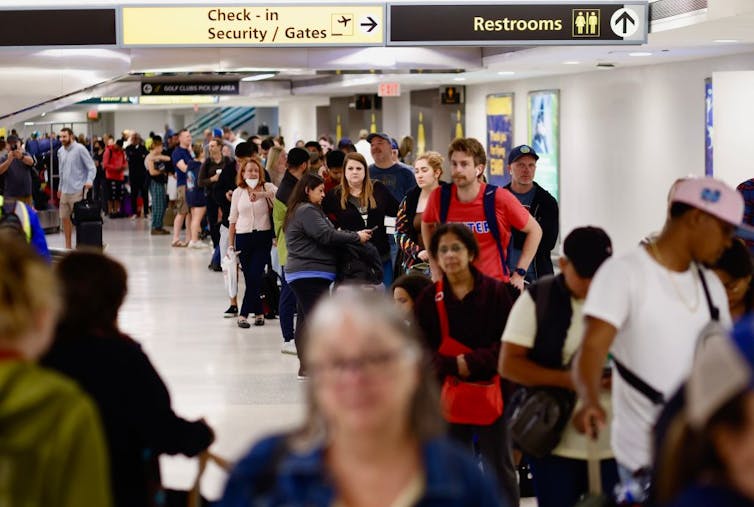
Recently at The Atlantic, reporter Amanda Mull wrote about the biometric screening company Clear, describing this firm’s high-tech service to skip the ubiquitous toil of identity checks before flight, at the cost of surrendering some privacy and personal information. Mull concludes the reason more travelers will likely enroll in this service is that “traversing American airport security is simply that grim.”
For Mull, the adventure of contemporary air travel isn’t the destination, or even the journey itself – it’s what you must do to get through the airport.
Still, it’s worth noting that the majority of the human population has never boarded an airplane; flying cross-country remains a relatively exclusive experience. For most people, the closest they’ll get to a coast-to-coast flight is seeing a small white scratch across the sky, as another airliner makes its arc at 35,000 feet.
2 futures of cross-country flight
Coast-to-coast travel is no longer about breakneck speed or defying elemental odds, and Earhart’s quests to push the limits of aviation couldn’t be further from the bland routines of contemporary air travel. Nor does it involve people dressing to the hilt to step aboard a jetliner for the first time, with passengers stowing their fancy hats in spacious overhead bins.
Where are the new frontiers for transcontinental flight today?
One area of innovation is in a greener form of flight. Solar Impulse, a completely solar-powered plane, took two months to fly coast-to-coast in 2013. It averages a plodding 45 mph at cruising altitude. As The Associated Press reported: “Solar Impulse’s creators view themselves as green pioneers – promoting lighter materials, solar-powered batteries, and conservation as sexy and adventurous. Theirs is the high-flying equivalent of the Tesla electric sports car.” Solar Impulse was more recently reconfigured as a remotely piloted aircraft, with new experiments in long-distance solar flight underway.

The comparison of Solar Impulse to a Tesla is handy because a different extreme can be found in Elon Musk’s company SpaceX. As part of the relentless development of its biggest vehicle, “Starship,” SpaceX has advertised the possibility of “point-to-point” travel on Earth: for example, flying on a commercial rocket from Los Angeles to New York in 25 minutes. Never mind the physical tolls of a normal 19-hour flight; it’s hard to imagine what such a brief yet fast trip would feel like, not to mention what sort of class divisions and bleak industrial launch sites such jaunts would rely on.
Get there as fast as possible, using as much fuel as necessary; or glide lazily along, powered by the sun, saving the planet. These are two starkly different visions of coast-to-coast flight, one a dystopian nightmare and the other a utopian dream.
In the middle, there’s what most flying mortals do: wait in lines, board unceremoniously and be relieved if you get to your destination without too much discomfort or delay.
Christopher Schaberg, Director of Public Scholarship, Arts & Sciences at Washington University in St. Louis
This article is republished from The Conversation under a Creative Commons license.





